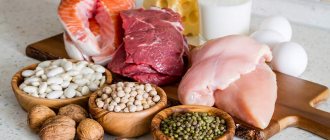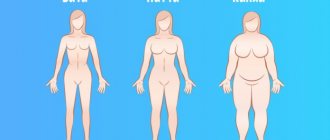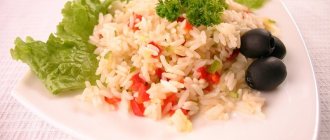Features of the elderly
The aging of the body cannot be stopped. Regenerative capabilities gradually decrease, psychomotor and protective functions slow down, and the activity of the gastrointestinal tract weakens.
To maintain good health in old age, it is important to maintain a balanced energy balance through a well-chosen daily diet. When developing a menu, several factors characteristic of older people are taken into account:
- slow metabolism;
- developing pathologies;
- sedentary lifestyle;
- development of constipation;
- frequent use of medications.
Medical nutrition
Eating “healthy” foods helps prevent many ailments; such nutrition can be called “therapeutic nutrition for the elderly.” For example, instead of animal fats, people over 60 are recommended to eat fish more often (mainly sea fish, with a high content of polyunsaturated fatty acids), this will help keep blood vessels in good condition and will prevent atherosclerosis, which is perhaps the most common disease among older people generations.
Parsley leaves and other greens, horseradish, garlic, and onions are also very healthy; they contain a large amount of vitamins, minerals and phytoncides and serve as a preventive measure for atherosclerosis and infectious diseases. It is especially good to add them to dishes in the spring, when fresh vegetables and fruits no longer contain many useful substances, and the body needs to replenish them after a long winter.
Also, in old age, you need to eat a lot of foods containing calcium (cottage cheese, cheese, kefir, fermented baked milk). But even with sufficient consumption of fermented milk products, there is often not enough calcium in the body of older people. This happens because the need for this mineral increases (the bones of an aging person gradually lose their mass), and its absorption from foods, due to the deterioration of the digestive system and a general decrease in metabolism, becomes worse. In such a situation, in order to prevent the development of osteoporosis, it is still recommended to add calcium supplements to the diet. Calcium absorption is facilitated by vitamin D, a large amount of which is found in fatty sea fish.
For normal intestinal function, elderly people are recommended to eat about 300–400g daily. fruits and berries. In addition to improving intestinal motility, such a diet helps lower cholesterol and blood clotting with a decrease in the proportion of prothrombin. Many fruits and vegetables contain potassium salts, which help normalize heart rate and the functioning of the vascular system.
Principles of nutrition
To avoid the negative consequences caused by natural age-related changes, as well as to maintain vigor for older people, following some important principles of proper nutrition:
- Diet variety. The daily menu must include fruit and vegetable varieties, greens, legumes and grains, dairy products, meat, fish, cereals, eggs, nuts.
- Compliance with drinking regime. After waking up in the morning, it is recommended to immediately drink a glass of filtered water. Drink enough liquid throughout the day.
- The predominant use of vegetable fats in cooking.
- Energy balance of nutrition. It is important to organize calorie counting throughout the day. This will allow you to avoid overeating, which has a negative impact on the body. At the age of over 60 years, the optimal daily energy intake varies between 2100-2350 kcal. After 80 years, this figure is 1800-2000 kcal.
- Prevention of atherosclerosis. The most common diseases that develop in old age are vascular atherosclerosis. It is important to reduce the risk of atherosclerotic plaques by reducing the consumption of animal fat, giving preference to fish.
- Fractional meals. It is advisable to consume food in small portions 4-6 times throughout the day. It is recommended to maintain the interval between dinner and falling asleep within 3.5-4 hours. This is important for slow metabolism, as it prevents the occurrence of excessive gas, heartburn, and sleep disturbances.
- Utility priority. When compiling a diet, preference should be given to easily digestible varieties of foods that have a beneficial effect on the functions of the gastrointestinal tract.
- Compatibility with medications. When your doctor prescribes medications, you should consult about combining them with specific types of food. Medicines often have an appetite suppressant effect, which impairs the functioning of taste buds.
- Determining the convenient consistency of food consumed. Dental health remains a common problem among older people. If there are difficulties in chewing, then preference is given to ground foods.
It is important not only to choose healthy products wisely, but also to prepare them correctly, preserving the vitamins and mineral compounds they contain. When served, dishes should look aesthetically pleasing, awakening the appetite. When preparing a diet, the individuality of the elderly person is taken into account, his food preferences, as well as his general health, are taken into account.
Special food for bedridden patients
Meals for bedridden patients should be tailored to their age, condition, illness and preferences. Menu planning should be done by a professional nutritionist or therapist.
First of all, it is important to maintain the correct water regime. You should not limit fluid even if a bedridden patient has urinary incontinence. The liquid allows you to cleanse the body of toxins and normalize digestion. The average water requirement should be 1.5 liters.
When creating a menu, you must be guided by the rules for organizing meals for older people. It is extremely important to avoid overeating and excessive consumption of fatty foods. Most of the fats and proteins of animal origin should be replaced with vegetable ones. Such products are digested and absorbed faster.
Permitted and prohibited products
The following products should be included in the daily diet of an elderly person:
- Cereals . Required for normal functioning of the gastrointestinal tract. Older people are advised to choose grains that are high in fiber.
- Fruits and vegetables . Can be consumed fresh or baked. Contain vitamins and minerals that slow down the aging process and improve the functioning of the immune system.
- Dairy . Required to provide the body with calcium. If milk is poorly absorbed by the body, you can consume fermented milk products. In addition, they improve digestion and prevent constipation.
- Meat and fish . Preference should be given to low-fat varieties. Helps stabilize blood pressure and strengthen blood vessels.
In old age, any diets that have not been prescribed by a specialist are prohibited. If you are overweight, the calorie menu may be slightly reduced, but not to the detriment of beneficial components.
It is recommended to limit fatty meats and poultry, processed foods, smoked foods, sweets, simple carbohydrates, carbonated drinks and strong coffee. You should also stop drinking alcohol. Meals should be fractional and the most high-calorie meals are recommended to be eaten in the first half of the day.
Healthy food
The organization of a balanced, healthy diet aimed at older people should begin with an analysis of the list of products that can benefit the body. Of course, personal preferences are taken into account, as well as possible individual intolerance to specific food varieties.
A fairly extensive list of products that serve as a source of compounds important for maintaining health and energy balance is allowed to be included in the menu of older people.
Squirrels
The body must receive a variety of protein foods. The protein contained in seafood is easier to digest, which is important when metabolic processes slow down with age. More often they include fish in the diet, in which the protein level is on average 15-20%.
The benefits of fish dishes are due to the inclusion of fatty acids, essential amino acids, various compounds beneficial to the body (for example, iodine, calcium, phosphorus), as well as vitamins, among which are ascorbic acid, A, E, D, group B.
Boiled or steamed lean meat and eggs are allowed. Includes nuts and seeds, which saturate the body with vitamins and polyunsaturated acids.
Fats
A balanced menu necessarily contains foods containing fat, but older people should give preference to vegetable oils, choosing unrefined varieties for use as a dressing.
Carbohydrates
Complex carbohydrates play an important role in a diet developed for an elderly person. They are absorbed more slowly, which helps normalize digestive processes, promote a long-lasting feeling of fullness, and prevent excess weight gain. Complex carbohydrates contain pectin, glycogen, starch, and fiber.
These beneficial compounds can be found in vegetables, various cereals, fruits, and bread products made from coarsely ground flour.
Macro- and microelements and vitamins necessary for the body
Natural aging of the body is reflected in a decrease in the quality of absorption of various useful elements.
It becomes relevant for people over 60 years of age to include in the menu not only fruit and vegetable products rich in compounds important for life. It is necessary to take mineral and vitamin complexes recommended by your doctor.
Calcium
The older a person gets, the more often he or she develops calcium deficiency, which leads to a decrease in bone strength and the development of osteoporosis.
To prevent such dangerous conditions, it is important to consume dairy products, choosing fermented milk varieties with low fat content. Ryazhenka, kefir, and natural yogurt are beneficial.
Natural products are the basis of health
An employee of a boarding house involved in preparing a diet for an elderly person works on the basis of recommendations from dietary nutrition specialists.
We carefully select products to create a nutritious menu. To ensure healthy, nutritious nutrition for our patients and maintain their physical and mental activity, we use:
- natural plant products rich in vitamins, antioxidants, iron, calcium, iodine, pectin and other substances beneficial to the body of an elderly person;
- all types of seafood, which contain essential vitamins and minerals, reduce the risk of cardiovascular diseases, heart attack, and are good for nerve cells and the brain;
- dairy products rich in calcium and proteins are introduced into the diet for the active functioning of the nervous system, muscle function, and reduce the risk of cancer;
- lean beef and poultry containing proteins, fats, vitamins and microelements. These products reduce cholesterol levels, are used in recovery diets, obesity, anemia, and strengthen the immune system.
The menu certainly includes:
- fruits and vegetables,
- berries,
- nuts,
- cereals and eggs,
- pumpkin seeds,
- juices,
- green tea,
- fruit decoctions and jelly.
We take care of our guests, select the most healthy products, treat them with sweets and homemade baked goods.
On holidays and birthdays, our chefs prepare a special holiday menu for our guests to make them feel comfortable, like at home.
Rational consumption of food
In old age, subject to a rational selection of food intake and the inclusion of gymnastic exercises and walks in the daily routine, it is possible to maintain cheerfulness, good physical shape, activity, a clear mind, and strong memory.
Rational consumption of food usually becomes relevant after reaching retirement age, when awareness of the value of health appears. It will help when independently developing a diet for the elderly to follow a number of recommendations from the World Health Organization, highlighting several types of products and their daily share.
Table 1. Daily intake of basic products
| List of products | Daily norm | Note | |
| 1 type | Potatoes, cereal dishes, bakery products | 40 % | Over the age of 65, daily intake should not exceed 1.5 kg |
| Type 2 | Vegetables, greens, fruits | Up to 35% | The daily recommended intake is 400 g. Dried and frozen varieties are allowed. Canned foods excluded |
| Type 3 | Protein types - fish, poultry, nuts, eggs, meat, legumes | ≈ 20 % | It is recommended to select lean meat varieties |
| 4 type | Dairy products | ≈ 5 % | Preference is given to products with low fat content |
| 5 type | Fats, sugar, oils, salt, drinks, flour products | ≈ 5 % | Select based on health status |
What is the best weight loss diet for older people for a week?
Diet for older people is not a temporary phenomenon, but a permanent one. This is a complete change in diet taking into account age, decreased physical activity, decreased vital energy and slow metabolism. An adjusted diet should contain the calories, vitamins and microelements that older people need and help restore the body. The age-related decrease in the activity of hormone production should also be taken into account.
Established eating habits, unfortunately, often lead to obesity, disruption of internal organs and the appearance of cardiovascular and gastrointestinal diseases. The aging process of the body in such a situation proceeds faster, atherosclerosis may appear, and muscle mass will gradually be replaced by fat mass, it will become harder to move, accordingly, this will reduce activity and accelerate other negative processes.
With psychological problems associated with the perception of one’s age and a decrease in vital energy, the opposite situations often occur when older people suddenly lose weight, lose their appetite, and decrease the absorption of essential vitamins and minerals.
Both cases require a conscious approach to changing your diet and lifestyle, as well as selecting the right diet.
Suitable foods for a diet for older people:
- Yesterday's bread, wholemeal or bran bread, but the main thing is not to eat rich pastries;
- A variety of soups in light broths: fish, vegetable, chicken breast or turkey, preferably not every day, but 2-3 times a week;
- Lean meat, ideally chicken breast, turkey or fish, but most importantly steamed or boiled;
- A variety of dishes from vegetables that do not irritate the gastric mucosa, which can be eaten both raw and boiled. At the same time, minimize spinach, radishes and sorrel cabbage soup;
- Any fruits and berries;
- Spices;
- Any cereals, but do not get carried away with pasta and rice;
- Milk and its derivatives, but fresh fermented milk products with low fat content are best, and you need to be careful with cream;
- You can eat eggs twice a week. Allowed boiled or in the form of an omelette;
- No more than 7 grams of salt should be eaten. per day;
- Confectionery products in very limited form;
- Seafood, lightly salted herring, light cheeses and low-fat sausages;
- Unrefined vegetable oil, but butter to a minimum, and margarine is not allowed at all;
- Vegetable, dairy, fruit sauces;
- Weak tea, coffee diluted with water or milk, freshly squeezed juices, compotes, fruit drinks, jelly, infusions of rose hips and sea buckthorn. Alcohol should ideally be completely eliminated.
Sample menu for a seven-day diet that we offer for older people:
Monday:
- For breakfast, tea with milk;
- For second breakfast, a salad of grated apple and boiled carrots, seasoned with lemon juice;
- For lunch, pea soup with vegetables and potatoes, cutlets, mashed potatoes and vegetable salad;
- For an afternoon snack, yogurt;
- For dinner, cutlets with onion filling, potatoes and vegetable salad.
Tuesday:
- For breakfast, tea with milk, cottage cheese and sandwiches with butter;
- For second breakfast, cereal with pieces of fruit or jam;
- For lunch, cauliflower soup, meat like beef stroganoff with mashed potatoes and a salad of fresh vegetables;
- For an afternoon snack, a bun with kefir;
- For dinner, baked eggplants with cheese, vegetable salad and mashed potatoes.
Wednesday:
- For breakfast tea with sandwiches;
- For second breakfast, various fruits;
- For lunch, borscht, stewed meat with potatoes and paprika salad;
- For an afternoon snack, kefir with cottage cheese;
- For dinner, rice porridge with compote.
Thursday:
- For breakfast, soft cottage cheese with bread and milk;
- For second breakfast, a bagel with yogurt;
- For lunch, beetroot salad with horseradish, beef broth with dumplings and boiled beef itself separately;
- Fruit for afternoon snack;
- For dinner, a straw with cream;
Friday:
- For breakfast, cocoa muffin;
- For second breakfast, sandwiches with liver pate;
- For lunch, vegetable soup, fresh tomato salad and mashed potatoes;
- Apples for afternoon snack;
- For dinner, vegetables, cheese and sandwiches with boiled sausage.
Saturday:
- For breakfast, bread with butter and cheese, tea with milk;
- For second breakfast, semolina porridge;
- For lunch, stewed cabbage with oven-baked pork and onion soup;
- For an afternoon snack, any fruit;
- For dinner, stuffed tomatoes with ham with rice, mashed potatoes and tea;
Sunday:
- For breakfast, sandwiches with butter and ham, coffee with milk;
- For second breakfast, any fruit;
- For lunch, pea soup, puree with mushrooms and fish, compote;
- For an afternoon snack, bread with sour milk;
- For dinner, cottage cheese and a piece of charlotte with compote.
Read the material on the topic: How to prevent a stroke
Regime organization
Knowledge of the basic principles of choosing products for the menu in old age allows you to easily organize an individually oriented diet and diet.
Having developed a meal schedule based on the recommendations of experts, it is important to adhere to it. When determining a menu that involves eating food 4-6 times a day, it is taken into account that the main meals should be the most nutritious. For snacks, choose light, low-calorie dishes.
For a diet with an average intake of 2000 calories, the proportion of free sugar should be 5%. The inclusion of fructose and sucrose in drinks and ready-made dishes is taken into account, and not just the use of granulated sugar for tea or coffee. An excess of free sugars (more than 50 g per day) negatively affects the condition of tooth enamel, causes excess weight gain, and causes the development of diabetes, hypertension, and cardiovascular pathologies.
It is important to consume no more than 5-6 g of salt per day, given its inclusion in a variety of finished products, for example, bread. It is advisable to add a minimum amount of salt to food during cooking.
Of the total daily calorie content, the share of proteins varies between 12-15%. Calculate the average requirement in old age with good health, taking into account body weight. It is recommended to maintain a ratio of 1 g/kg. In case of pathological changes, the protein norm is increased. It can be 1.5 g/kg.
They prefer boiled, stewed, baked dishes. It is useful for elderly household members to steam meat and fish delicacies. Try to reduce the consumption of fried foods as much as possible.
You need to eat vegetables, beans, and other legumes, as well as fruits in small portions daily. They are usually used to organize possible additional snacks. Whole grains will benefit you.
Fruit and vegetable varieties rich in fiber are recommended to be consumed raw. Usually they are first crushed using a blender or grater. The inclusion of such food in the daily menu helps to normalize the functions of the gastrointestinal tract.
Fish, as a priority source of protein, is introduced into the diet 2-3 times a week. Alternate it with eating lean meats. It is recommended to cook first courses in rich meat broth no more than once every 6-7 days. It is useful to eat a handful of nuts or seeds every day - sunflower, pumpkin.
Legumes that help prevent or slow down the development of cardiovascular pathologies and osteoporosis can be used for cooking every other day. Contraindications are taken into account, including kidney and joint diseases, gout.
Eggs (1-2 pieces) are allowed for consumption every 3-7 days. As a salad dressing for adding to porridge, unrefined varieties of vegetable oil are used, which contain a large amount of healthy fats.
Dill, lettuce, parsley and other varieties of fresh herbs, which saturate the body with a variety of vitamins, allow you to diversify the menu.
Fasting in old age is contraindicated, but fasting days can be beneficial in the absence of serious pathological abnormalities after receiving medical advice.
Principles of nutrition for elderly and senile people
June 16, 2021
Gerontology
– a science that studies the aging process, its biological, medical (geriatric), social, psychological, hygienic and social aspects.
The main goal is to ensure a high quality of life for an elderly person
in society, his active participation in economic, socio-political and cultural life, using the experience and wisdom of people of the older generation.
There is a trend of continuous growth in the number of older people in the world. At the same time, 90% of elderly and senile people suffer from diseases of internal organs, which increases the burden on the healthcare system.
Currently, an age classification has been adopted, according to which the population over 50 years of age is divided into three groups:
- people of mature age 50 - 60 years old;
- elderly people 61 – 74 years old;
- elderly people aged 75 years or more;
- people aged 90 years and older are classified as centenarians.
Aging
– this is
a natural
process that awaits any person. It is based on a slow accumulation of age-related changes that manifest themselves at all levels of the body, including the digestive system:
- The motor and excretory functions of the stomach are reduced. Such changes are typical for 80% of people over 50 years of age.
- The acidity of gastric juice decreases.
- The rate of absorption of nutrients in the small intestine decreases by 2-3 times. Possible deterioration in the absorption of fats and carbohydrates.
- The functioning of the cardiovascular system deteriorates, age-related changes are observed in the pancreas, salivary glands, and liver.
Basic principles of nutrition for practically healthy elderly and old people:
- correspondence of the energy value of the diet to the actual energy consumption of the body;
- preventive nutrition, taking into account the prevention or slowdown of cardiovascular diseases (CVD), diabetes mellitus (DM), cholelithiasis (GSD), cancer, osteoporosis and other pathologies common in old age;
- compliance of the chemical composition of the diet with age-related changes in metabolism and functions of organs and systems;
- variety of food set;
- the use of foods and dishes that are sufficiently easy to digest, in combination with products that moderately stimulate the secretory and motor function of the digestive organs, normalizing the composition of the intestinal microflora;
- correct diet with even distribution of food over separate meals;
- individualization of nutrition, taking into account the metabolic characteristics of specific elderly and old people, their personal long-term eating habits.
It is important to understand that with age, energy consumption and basal metabolism decrease, physical activity decreases, and muscle mass decreases.
This leads to a natural decrease in the need for nutrients and energy. The recommended calorie intake for people over 60 years of age is:
- for women - 1900-2000 kcal
- for men - 2000-3000 kcal.
In this case, the following distribution of calorie content by meals is recommended:
1st breakfast - 25%
2nd breakfast - 15%
Lunch - 35%
Dinner - 25%
Compliance with the diet is necessary to stimulate the secretion of gastric juice. In this case, the intervals between meals should not exceed 4 hours.
The optimal ratio of macro- and micronutrients is a fundamental factor in healthy digestion, especially in adulthood and old age.
Protein deficiency
causes various disorders - decreased muscle strength, physical fatigue with the slightest effort, etc.
The optimal daily protein intake is 1.0 – 1.2 g per kg of normal body weight. The proportion between animal and plant proteins in the diet is 1:1.
Among animal proteins, preference should be given to protein from fish and dairy products and limit the consumption of meat and meat products. fast days 1-2 times a week
. The most useful are river fish (pike perch, pike, carp), and among sea fish - cod varieties.
It is recommended that older people include up to 30% protein in their diet from dairy products
(100 g of cottage cheese per day), low-fat or low-fat, 10-20 g of cheese of any kind, preferably mild and non-salty varieties.
Optimal fat intake
– 0.8-1 g per kg of normal body weight, energy value no more than 30% of the daily calorie content (76-85 g per day).
It is important to consume fats of vegetable origin ( sunflower, corn, olive, flaxseed, pumpkin and other oils
), which have a stimulating effect on oxidative processes in the body. Vegetable oils have the highest content of biologically active polyunsaturated fatty acids (PUFAs) and monounsaturated fatty acids (MUFAs).
It is worth paying attention to the benefits of sea fish and seafood. And among animal fats, butter
, as the most easily digestible and rich in vitamin A. It is recommended 5 g per day with prepared food, before direct serving.
Carbohydrate diet
should be reduced to 200-300 g. These carbohydrates should be distributed between complex carbohydrates (50-55%), potatoes (20%), vegetables and fruits (5-10%) and dairy products (20%).
The amount of regular bread, which is a product subject to strong fermentation, should be reduced to 100-200 g. Wholemeal bread
.
Fresh vegetables
can be consumed in large quantities. Leeks, artichokes, asparagus, green beans, carrots, turnips, beets, cabbage, prunes contain fiber - a waste product that is extremely valuable for intestinal motor function.
Fruits
should be consumed mainly fresh. If eating fruits in old age is associated with stool retention and increased gas formation, it is better to consume them boiled or baked.
Acute intestinal and other chronic infections play a role in the formation of the intestinal microflora of older people; long-term use of medications that affect microflora; chronic diseases of the gastrointestinal tract (GIT), accompanied by a decrease in the secretory function of the stomach and pancreas.
To create optimal intestinal endoecology, normalize the gastrointestinal tract, activate motility and absorption in the intestine, it is necessary to provide the body of an elderly person with a sufficient amount of dietary fiber (cellulose, hemicellulose, pectin, lignin, etc.). It is also advisable to introduce fermented milk products and dietary supplements, bifidofactors into the diet.
It is necessary to provide the elderly person with sufficient
In old age, vitamin deficiency often occurs due to changes in the activity of enzyme systems, therefore it is worth paying attention to the prevention of deficiencies.
B vitamins,
due to their catalytic properties, they are able to inhibit the development of aging processes, including
vitamins B12 and B6
, help reduce the risk of developing the atherosclerotic process.
Particular attention should be paid to the intake of antioxidant vitamins ( C, E, A, beta-carotene
), bioflavonoids, which provide protection to cellular biomembranes. It is also necessary to increase the consumption of vitamins E, C, group B, D and PP and others. In addition to vitamins E and D, it is necessary to use vitamin C and folic acid.
At the same time, folic acid deficiency
(B9) promotes atherosclerosis, mental disorders, apathy, poor wound healing, and susceptibility to infectious diseases.
Vitamins should be supplied to the body moderately and comprehensively. Being antioxidants and immunomodulators, vitamin-mineral complexes perform the function of geroprotectors.
Equally important is adequate dietary intake of minerals.
Older people often experience mild forms of iron deficiency anemia and changes in bone tissue caused by impaired metabolism of calcium and iron in the body.
The aging body is able to accumulate calcium in the walls of blood vessels, while calcium deficiency leads to osteoporosis and bone fractures. The effect of calcium on iron absorption can be reduced by reducing calcium intake at breakfast and lunch, when the bulk of dietary iron is supplied. Limiting calcium intake in general is undesirable, since in many cases there is an increased need for both elements. The solution to the problem is vitamin-mineral complexes, which provide separate administration of calcium and iron.
The most important aspects of ensuring high nutritional value and hygienic reliability of gerodietetic products are the selection of appropriate raw materials and additives, their qualitative assessment and the development of methods for their introduction into products.
To summarize, it is important to take into account age-related changes in the body and optimize the diet to suit its individual characteristics.
Photo by MART PRODUCTION: Pexels
Tags:
- Nutrition
- Gerontology
- Prevention
2 comments • To leave a comment you must be an authorized user
- DunKarmachka Thank you, I’m now in menopause, I’ve gained weight, and I can’t lose it as easily as in my youth. Of course, I try not to get hung up on it, I drink Lady’s formula menopause enhanced formula, it contains clover extract, it contains plant estrogens, to normalize hormonal levels. It also increases collagen production, there are fewer wrinkles, the mucous membranes are normal, libido has improved, and the joints do not bother.
- Gankka At any age you need to support your body. Many people work into old age, lead an active lifestyle, and all this requires strength. I take fruttilar multivitamins, several courses a year. There are many components in the composition - iodine, zinc, selenium. My performance improves, and I get sick much less often. By the way, I note that they come in the form of strawberry-flavored marmalade lozenges, especially for those who don’t like to swallow pills.
Sample weekly menu
Creating a menu that benefits older people is always personal-oriented, but the basis for development is usually the example offered by experts.
Table 2. Weekly menu
| Breakfast, 7-00 | Lunch, 11-00 | Lunch, 13-00 | Afternoon snack, 16-00 | Dinner, 19-00 |
| MONDAY | ||||
| Rice milk porridge; boiled grated carrots with apple; tea; cookie | Green tea; slice of rye bread with cheese | Vegetable salad with herbs; green pea soup; fish cutlet with mashed potatoes; rosehip compote | Glass of fermented baked milk | Boiled vegetables with veal cutlet; baked apple |
| TUESDAY | ||||
| Oatmeal milk porridge; curd cheesecakes; green tea | Drink made from chicory with added milk; ham sandwich | Cauliflower based soup; stewed lean beef with vegetables; cranberry compote | Large apple | Cheese eggplant casserole with mashed potatoes, jelly with fresh berries |
| WEDNESDAY | ||||
| Millet milk porridge; pear or apple; cocoa | Whole tea grain bun; banana | Salad based on blanched sweet peppers; vegetable soup with beef; steamed chicken meatballs with rice garnish; prune compote | Curd mousse, rosehip compote | Baked fish; Tea with lemon |
| THURSDAY | ||||
| Corn milk porridge; barley coffee; cheesecake with jam | Slightly warmed milk; biscuit slice | Fish soup; vegetable stew; green tea | Steamed dried fruits | Cabbage pancakes; yogurt |
| FRIDAY | ||||
| Oatmeal without milk; boiled egg; green tea; cookie | Cocoa with added milk; chicken pate sandwich | Tomato soup with rice; steamed veal steak with stewed vegetables; compote with rose hips | Hard cheese; grape | Tomatoes stuffed with minced meat and rice; kefir |
| SATURDAY | ||||
| Buckwheat porridge; cocoa with milk; cheesecake | Black tea; rye sandwich with cheese and butter | Lentil soup with croutons; steamed fish with mushroom sauce and boiled potatoes; cranberry jelly | Fruit platter | The vinaigrette; Varenets |
| SUNDAY | ||||
| Two egg omelette; banana; green tea; cake | Chicory with milk; slice of rye bread with ham | Meat broth soup with vegetables; boiled chicken breast with a side dish of pasta; fresh fruit | Rye bun with orange jam; kefir | Veal zrazy with boiled vegetables; yogurt |
The proposed menu option can serve as a guide, as it includes varieties of products recommended for older people. Designed for 5 meals, but if desired, you can add a light snack 3-4 hours before bedtime.
Table 3. Approximate daily diet
| Eating | Advantageous dishes | Weight, volume, quantity |
| Breakfast | Milk porridge | 170 g |
| Boiled egg | 1 PC. | |
| Tea, cocoa | 200 ml | |
| Cookies, cupcake, cheesecake | 30-50 g | |
| Lunch | Tea, chicory, cocoa, milk | 200 ml |
| Sandwich, bun, biscuit | 25-30 g | |
| Dinner | Soup | 350 g |
| Salad | 100 g | |
| Boiled chicken, meat, fish | 100 g | |
| Garnish | 140-150 g | |
| Beverages | 200 ml | |
| Afternoon snack | Fresh fruits | 120 g |
| Cottage cheese | 40 g | |
| Beverages | 200 ml | |
| Dinner | The vinaigrette | 100 g |
| Zrazy | 70-100 g | |
| Fish | 70 g | |
| Vegetable cutlets | 100 g | |
| Casserole | 100 g | |
| Fermented milk drinks | 200 ml |
There are no strict parameters for daily portions, but it is important not to overeat to facilitate bowel function. When selecting flour products, it is recommended to give preference to dietary varieties.
Proper diet for older people
As mentioned earlier, elderly and elderly people should eat in small portions 4-5 times a day. In addition, it is necessary to select the calorie content of dishes in such a way that the number of calories is correctly distributed by time of day:
- first breakfast - 20% of the total meal,
- second breakfast - 15%,
- lunch - 45%,
- dinner - no more than 20%.
With five meals a day, lunch and dinner may be less voluminous, and the menu will additionally include an afternoon snack. For the second dinner (before bed), if desired, you can eat fermented milk products, which are very healthy, do not put a strain on the digestive system and are not harmful to health.
Restrictions and prohibitions
When carefully organizing a menu aimed at the elderly, specific recommendations on the need to limit or even completely eliminate some harmful products must be taken into account.
The purpose of the restrictions is to prevent the development of the negative consequences of illiterate nutrition, which include cardiovascular and gastrointestinal pathologies, obesity, and diabetes.
List of undesirable products that require reduction in the menu:
- sugar;
- polished cereals;
- cakes, pastries;
- smoked meats;
- confectionery;
- pickles;
- spicy food;
- jam;
- pasta, especially soft varieties;
- canned food;
- fatty meats;
- White rice;
- strong coffee;
- mayonnaise;
- alcohol;
- marinades.
Sweets can be replaced with dried fruits if desired. You can eat fresh berries.
It is recommended to completely remove the following foods from your diet:
- carbonated sweet drinks;
- sausage;
- fast food.
It’s easy to avoid harmful foods by creating a balanced, healthy diet. In the absence of contraindications, you can eat the above types of food in small quantities, but you should include them in the menu no more than once or twice a week.
Dietary recommendations for older adults
What is a balanced diet for older people?
First of all, the diet of people in the older age category should be varied. The menu should contain a lot of fermented milk products, cottage cheese, lean meat, sea fish and other seafood, eggs, bakery and confectionery products (in small quantities), whole grain cereals, pasta (preferably from durum wheat), as well as a lot of fresh fruits and vegetables, dried fruits and berries (dishes prepared from them - compotes, fruit drinks, jelly).
A variety of foods will not only cover the body’s need for vitamins and minerals, but will also always be consumed with appetite and pleasure.
The type of heat treatment of cooked food deserves special attention. It is not recommended for older people to consume a lot of fried foods; preference should be given to boiled, stewed, baked, or steamed foods. Such food retains a maximum of nutrients, is not harmful to health and is easily digestible.
You should exclude salty foods from your diet (salt retains fluid in the body and provokes an increase in blood pressure), smoked foods (they contain many harmful substances), and limit the amount of canned food, since they practically do not contain vitamins (they are destroyed during technological processing).
“Wrong” food, especially consumed in old age, provokes the appearance or exacerbation of serious diseases, such as gastritis, ulcers, inflammatory diseases of the pancreas, liver, gall bladder, etc.
For weakened old people and bedridden patients with serious illnesses (if a person cannot chew food on his own or even has difficulty swallowing), the only option for fully supplying the body with all the necessary vitamins and minerals is nutritional mixtures for the elderly.
It is also allowed to use baby food when feeding the elderly. Such food products are healthy and easily digestible; they are easy for weakened people to consume.
Nutrition in old age with various diseases
It is especially important for older people to create a thoughtful diet if they have been diagnosed with certain pathological conditions.
For chronic constipation
Deterioration of stool, consisting in the development of constipation, is observed quite often in old age due to a decrease in the activity of intestinal peristalsis.
In such a situation, in order to improve the condition, it is recommended to include beets, carrots, as well as cucumbers and zucchini in the menu. You need to abstain or limit the consumption of legumes and potatoes as much as possible.
Berries help, except blueberries and lingonberries. Be sure to include fresh, frozen or dried fruits in your daily menu. It is useful to eat buckwheat, millet, oatmeal, lean fish, lean meat, and fermented milk drinks. Sauerkraut, oatmeal cookies, rye bread, and greens are recommended.
For hypertension
To alleviate the condition caused by frequent increases in blood pressure, it is important to introduce foods containing potassium into the diet. You need to eat broccoli, kiwi, bananas. Citrus varieties, grapes, and dried apricots help normalize blood pressure.
Nutrition for pneumonia in the elderly
The development of a diet for the development of pneumonia is based on the need to strengthen the immune system and reduce intoxication. Select products with anti-inflammatory characteristics to reduce the risk of negative side effects.
At the first stage of the disease, drink plenty of fluids (the daily norm is at least 1.5 liters). Food is consumed in crushed or semi-liquid form up to 7 times a day. Reduce the amount of simple carbohydrates and animal fats as much as possible.
The menu is based on easily digestible food varieties: slimy porridge, low-fat cottage cheese, chicken broth, fresh juices, chicken meat. Among the drinks with anti-inflammatory effects, decoctions are recommended - blackcurrant, rosehip, as well as cranberry juice, tea with lemon.
Gradually, as the severity of severe symptoms decreases, more protein foods are included to activate the defenses - fish, lean meat, cottage cheese, eggs.
For diabetes
In order to prevent complications caused by the development of diabetes, the diet is carefully monitored, from which flour, fatty and fried foods are excluded, and sugar is limited. The advantage in the menu should belong to dairy and vegetable (excluding potatoes) products.
For arthritis, arthrosis
It is recommended to consume more vegetable and fish dishes. The compounds they contain help reduce inflammatory processes and help prolong the remission stage.
Features of a balanced diet
Nutrition in old age should be low in calories and at the same time fully satisfy the body's need for nutrients. These substances include:
- Squirrels . With age, the need for proteins decreases significantly due to decreased physical activity and slower regenerative processes. However, you should not completely eliminate it from the body. It is required for the restoration of tissues and cells. Partially animal protein can be replaced with vegetable protein.
- Fats . The amount of fat in the body should be limited. However, the diet must contain vegetable oil, which is required for the intake of polyunsaturated fats into the body of an elderly person.
- Carbohydrates . In the diet of an active older person, the amount of carbohydrates should be approximately four times the amount of protein. For people with low physical activity, reduce the amount of carbohydrates and replace them with whole grain and high-fiber foods.
Fresh fruits and vegetables are of particular value in the diet of an elderly person. They saturate the body with vitamins that slow down the aging process and normalize the functioning of the cardiovascular and nervous systems.
The need for minerals in old age is lower. Of particular importance is calcium, a deficiency of which leads to brittle bones, and an excess leads to the deposition of salts in cartilage and blood vessels. Therefore, the dosage of additional supplements should be prescribed by a specialist based on nutrition.










